5-Year Accessibility Plan 2024-2028
This is the NYC Mayor's Office of Contract Services 5-Year Accessibility Plan 2024-2028, created by the Chief Diversity Office on March 20, 2024.
Download a PDF file version of this plan.
Background
Local Law 12 of 2023 requires every New York City agency to develop and implement a five-year accessibility plan, in consultation with the Mayor's Office for People with Disabilities ("MOPD"). The legislation mandates that the accessibility plans outline the steps agencies are taking to "ensure that the agency's workplace, services, programs and activities are accessible to and accommodating and inclusive of persons with disabilities" by improving physical, digital, and programmatic access, and providing effective communications for persons with disabilities.
These efforts include, but are not limited to: any alterations or structural changes to facilities or premises that are owned and operated by the agency or contracted for use by the agency or otherwise under the agency's jurisdiction; any planned upgrades or investments in technology or tools that will improve accessibility within the agency or access to such agency's services and programs; and additional steps to make the agency's programs and services more accessible to and inclusive of persons with disabilities.
Executive Summary
The Mayor's Office of Contract Services (MOCS) is a New York City oversight and service agency that is dedicated to optimizing existing operations and transforming processes to make it easier to do business with the City. As the owner and manager of PASSPort (Procurement and Sourcing Solutions Portal), the City of New York's end-to-end digital procurement platform, MOCS is charged with supporting agencies, vendors, and the general public in understanding, accessing, and participating in Citywide procurement in addition to all other services including public hearings, trainings, webinars, and events.
MOCS believes in an equitable, diverse, and inclusive environment. MOCS is committed to providing persons with disabilities with access to the Department's services; to identifying, preventing, and removing barriers to accessibility; and to meeting accessibility requirements in a manner that respects the dignity and independence of persons with disabilities.
This plan serves as MOCS' approach to ensure everyone has access to our services, taking away the barriers that stop people from participating, particularly those persons with disabilities. Persons with disabilities refers to those who experience physical, mental health, cognitive, communication, intellectual, sensory, or age-related changes whether they are seniors, others with age-related changes, or people with lived experience of mental health concerns or substance use issues.
For the purposes of this strategy, the City will use the term, persons with disabilities, which will reference the complexity and diversity of lived experiences as outlined above and adopts a definition of disability that is broad and inclusive.
In this Five-Year Accessibility report, MOCS will address:
- Access to our office space as a guest or staff member.
- Access to in-person and virtual meetings, including public hearings, trainings, and events.
- Communication strategies to make our website and social media pages accessible.
- Human Resources and EEO practices that ensure accessible and equitable processes.
This plan is a living document that will be made available for public comment. MOCS wants all community voices heard and will incorporate recommendations feasible for MOCS to implement.
Methodology
Because of the scope of this accessibility plan, it was imperative to include staff from units in every touchpoint of our operations, internally and externally. As such, members from the following divisions were required to participate in the internal accessibility plan workgroup: Chief Change Office (which includes Communications and Learning & Development), General Counsel, Equal Employee Opportunity, Chief Technology Office, Finance (which includes Facilities), Chief Diversity Office and Human Resources. The accessibility plan workgroup met weekly over three months to discuss plan requirements, areas of impact, and management of data collection and write up.
To assist the workgroup in identifying information needed, MOCS distributed the self-evaluation tools provided by the Mayor's Office for People with Disabilities (MOPD) to each workgroup member. These self-evaluation tools acted as a guide on what our staff needs to review and consider when developing their plan. This tool also provided guidance on areas we should consider addressing, if feasible. MOCS also participated in presentations provided by MOPD and other partners on addressing accessibility in our day-to-day practices and improvements for consideration.
Each division's analysis was consolidated to create this report. Once the public comment is received, the accessibility plan workgroup will reconvene and incorporate those recommendations that are feasible to implement.
Agency Mission
The Mayor's Office of Contract Services works with agencies, vendors, and providers to ensure that the contracting process is fair, efficient, transparent, and cost effective to the City.
Our mission is to lead procurement transformation by leveraging expertise, innovation, and a results-oriented mindset. Our vision is to provide equitable procurement through transparency, accountability, and efficiency.
We accomplish this by embracing our five values to guide our daily work:
- Accountability - Responsible use of tax-payer dollars and commitment to high quality service for all New Yorkers.
- Get Results - Maximize strategic, efficient procurement to get stuff done for key city initiatives.
- Innovation - Transform policies and practices to bring procurement into the modern digital era.
- Leadership - Lead through excellence in policy, process, and technology to bring a strategic approach to NYC procurement.
- Equity - NYC procurement must reflect the diverse City we live in, and the process should be simple and accessible for all.
Contact Information
MOCS' Chief Diversity Office is responsible for preparing and updating the agency's Accessibility Plan. MOCS' website contains useful information for individuals with disabilities, including:
- Notice of Rights under the Americans with Disability Act
- Grievance Procedures under the Americans with Disability Act
- Disability Service Facilitator (DSF) contact information
- Contact form to directly email the DSF
- Five Year Accessibility Plan
For information, refer to the Digital Access page.
Accommodations Requests
Under Local Law 27 of 2016, every City agency is required to appoint a Disability Service Facilitator ("DSF"). The DSF coordinates agency efforts to comply with and carry out the agency's responsibilities under the Americans with Disabilities Act ("ADA") and other federal, state, and local laws and regulations concerning access to agency programs and services by persons with disabilities. These individuals are liaisons to New Yorkers with disabilities, connecting people with disabilities to City government. Employees and/or members of the public who need assistance accessing a particular program or service, should contact MOCS' DSF Melissa Rodriguez at (212) 298-0800 or click the online comment form found on our accessibility webpage.
Availability
Individuals may request a copy of this MOCS Proposed 5-Year Accessibility Plan in an alternative format that is accessible to them by contacting the DSF at (212) 298-0800 use the online comment form found on our accessibility webpage.
Agency Plan
Physical Access
a. Approach & Entrance:
MOCS is located at 255 Greenwich Street, 9th floor, New York, NY, 10007. As MOCS is not the primary lease holder of the 9th floor, nor the largest City agency occupying space at this address, MOCS will rely on the Office of Management and Budget (OMB)'s 5-Year Accessibility Plan for detailed information regarding the building's public spaces, including signage and access to the building lobby, turnstiles, stairwell, and elevators. Please refer to OMB's 5-year Accessibility Plan at https://www.nyc.gov/accessibilityplans for information regarding the aforementioned areas.
While MOCS is not responsible for addressing the building's general public spaces, MOCS has reported to Building Management the lack of parking for visitors and identified concerns with ADA signs at the main exterior entrance regarding the contrast and measurements of these signs.
b. Access to Office:
MOCS focuses on two crucial areas for public access: the reception area, serving as the main entrance and accessible route, and the Boardroom, used for meetings subject to NYC's Open Meeting Law. The ramp leading to our office features a single handrail with no handrail on the opposite side. Full-size elevators meet ADA standards and include features for people with limited vision.
For MOCS staff, the office aisle spaces and cubicles meet the ADA standard for wheelchair accessibility. To date, MOCS has not needed to purchase an ADA wheelchair accessible table or desk. However, MOCS is identifying vendors for future purchase of such equipment, if needed.
c. Signage:
MOCS has various signs in public spaces and within the office, including wayfinding signs. These signs, composed of cad vinyl print, do not meet standards, as per the self-evaluation checklist provided. However, MOCS will address this by adding more accessible signage at 15 locations, including the main entrance, pantry, library, multi-use room, file room, supplies, storage, boardroom, Director's office, and the conference rooms named Turquoise, Plum, Purple, Indigo, Director, Blue, and Midnight.
d. Restrooms:
Recent renovations improved ADA accessibility in the men's and women's restrooms, incorporating features such as an automatic door for the men's room and a wider accessible stall. However, measurements confirming accessibility for these modifications should be found in the OMB's 5-year Accessibility Plan.
e. Fire Systems:
The 9th floor is equipped with strobe lights and speakers in various sections: East, Central, West, Pantry, Reception and shared common spaces, ensuring compliance with fire safety standards. The Building's Fire Safety Director confirmed there is a fire and emergency management plan in place that accounts for employees and visitors with disabilities, including communicating such plan. MOCS has a Fire Safety/Emergency Action Plan, along with MOCS staff in designated roles who have been trained in the event of a fire or other emergency, with respect to staff and others with disabilities and functional needs to assist in various scenarios. The Occupants Requiring Assistance guide can be found in Appendix A.
f. Next Steps
MOCS is reviewing the following improvements to our office's physical access:
- Consider measuring the steepness of the ramp to ensure there is no concern of the angle.
- Determine if adding an additional handrail to the other side of the ramp is feasible for better stability.
- Develop accessible specifications of signage to replace current ones throughout the office and determine costs.
Photographs of MOCS physical office space can be found in Appendix B.
Digital Access
a. Website
The MOCS digital accessibility approach for its website nyc.gov/MOCS is in alignment with internally recognized standards and guidelines as set forth by the Web Content Accessibility Guidelines 2.1 (WCAG) and Local Law 26 of 2016. Employees who create and maintain digital content are aware of and apply these laws and standards.
The MOCS website was first evaluated for WCAG conformance in 2021 and then completely redesigned in 2022 to ensure digital accessibility and improve the user experience so that vendors and prospective vendors, including non-profits, and procurement personnel can quickly and easily find the information they need. The website redesign was implemented with the support of the Office of Technology and Innovation (OTI) and a NYC-based M/WBE certified small business with more than 30 years of web design and digital accessibility experience.
For new web content and the maintenance of existing web content, MOCS has protocols in place to ensure digital accessibility. All web content requests are being reviewed and content optimized for digital accessibility in accordance with the web development recommendations set forth by the Office of Technology and Innovation (OTI). This is also applicable to other MOCS public facing websites PASSPort Public and BuyWise.
MOCS staff managing the MOCS website have been trained on the topic of digital accessibility. They completed the required Digital Accessibility Training Sessions provided by the Mayor's Office for People with Disability (MOPD) and the Office of Technology and Innovation (OTI).
MOCS implemented a quarterly web content review process in the Fall of 2023 to ensure all web content listed on the MOCS website is accurate, easy to find, and in conformance with WCAG 2.1.
As part of the quarterly review process, alt text descriptions for images will be reviewed as well to address alternative text descriptions that are not generic, AI generated.
Videos that are hosted on YouTube offer the turning on (or off) of closed captioning (CC). The most frequently watched videos (PASSPort training videos for vendors) have been made available in Spanish language in 2022. None of our videos have American Sign Language (ASL) interpretation either built into (video-in-video) the original video or have a separate ASL version which is linked to from the page of the original. Similarly, none of our videos have audio descriptions, either as part of the original or as a separate version with a link to it from the original's page.
With the support from the Mayor's Office for People with Disabilities (MOPD), MOCS developed in 2022 several new resources for MOCS staff to meet digital accessibility conformance going forward, including:
- A template and style guide to create PASSPort guides (step-by-step instructions with screenshots)
- Best Practices: Materials (guide)
- Best Practices: Videos (guide)
- Best Practices: Presentations and Webinars (guide)
- MOCS Training Primer (recorded webinar)
- Plain Language (recorded webinar)
To boost agencywide awareness and knowledge on how to create accessible documents, MOCS has shared and promotes MOPD's Digital Accessibility Resources with all MOCS staff.
There is a review process in place to ensure electronic documents are accessible prior to public distribution but not consistently. A process will be put into place to proofread accessibility and add ALT text for the remediation of documents previously created that are not currently accessible. MOCS does not offer podcasts but is in the process of procuring a learning management system to produce self-paced online courses that conform with the latest digital accessibility requirements. This system conforms to WCAG 2.0 AA for both the learner experience and the administrator experience.
MOCS has changed the way PASSPort end-user guides are being produced. Instead of publishing Acrobat Reader PDFs that are largely inaccessible to screen readers, all new guides starting in November 2023 are being published as web pages. This allows for improved accessibility, including a seamless experience when translating the page contents. Page visitors can simply click the "Translate" button and select from any of the 132 available languages to translate web content, including PASSPort guides.
b. Software
PASSPort, the City of New York's end-to-end digital procurement platform, continues to grow and expand in scope. System fixes and system enhancements are being implemented on an ongoing basis. PASSPort was reviewed for language accessibility in 2021. The latest larger PASSPort enhancements release, rolled out in November 2023, included several new digital accessibility features to improve readability and ease-of-use. This included a new in-system help feature, a new high-contrast mode option, a Google Maps plug-in, and enhanced functionality and visibility of filter features, alert messages, and page layouts.
The Microsoft Teams platform used for public meetings has built in accessibility features to support individuals with disabilities, such as closed captions features and an AI-generated transcription caption feature that upon request can be enabled. To our knowledge, most organizers who run virtual or hybrid meetings may not be aware of the best practices for accessibility. Microsoft accessibly features are also available with Power Bi which MOCS will be offering as a reporting tool to City agencies. Microsoft provides details on their accessibility tools on their website.
The internal applications Citrix and Pulse VPNs are remote desk systems utilized by staff when working out of the office. Both Citrix and Pulse are not accessible, but these remote systems are a gateway to access the remote desktop which have accessible resources. The accessibility resources are available for users to enable letters, e-readers are also an alternative choice that can help navigate and assist users through the website. The Office of Technology and Innovation (OTI) made recommendations on having a pre-configured accessible desktop in the event one is needed. Microsoft Office, Adobe, Teams, utilized by MOCS staff, are accessible.
There has not been any recent testing proposed for users with disabilities. However, MOCS is working with the procurement team to engage vendors on better understanding of what accessibility tools and software are available (i.e., screen magnifiers, readers, switch adapted mice and keyboards) that can meet the need for users with disability requirements.
Although IT has not received any employee complaints in regard to accessibility issues with our internal systems, MOCS is researching with the procurement team accessibility software and tools to have readily available should this equipment become necessary.
MOCS currently does not develop any mobile applications nor have or use any Digital Kiosks. If this changes in the future, MOCS will ensure accessibly functionality is made available.
c. Next Steps
MOCS is looking to monitor and expand its digital accessibility approach through the following:
- Implement annual web content review process for WCAG conformance.
- Review results will be documented and shared with all web content developers.
- Results will be used to help inform future internal training.
- Develop and promote a clear, well-defined, ongoing accessibility training program agencywide.
- Ensure continued role-based digital accessibility training.
- Customize training by organizational role to facilitate the development of the relevant competencies in digital accessibility.
- Continue to evaluate the MOCS website and PASSPort for digital accessibility improvement opportunities to further enhance the user experience.
- Get subscription to user testing software for MOCS websites with screen readers to test with different disabilities.
- Research technical solutions to add closed captioning and subtitles (to access translations) to videos for enhanced user experience.
- Learning & Developing Team is considering instituting a review process before content goes live.
- Learning management system training and utilization to commence January 2024.
- Documentation and training of MS Teams accessibility features will be provided to staff.
Effective Communications
In service of the almost one million New Yorkers who have some form of disability, the Mayor's Office of Contract Services (MOCS) is working on the full-scale implementation of communications accessibility practices. The goal is to ensure every New Yorker has an equal experience when receiving agency communications or interacting with the agency's social media content.
a. Social Media
Social Media is a powerful way to engage with New Yorkers and learn more about their needs. The MOCS LinkedIn, Instagram, and X (formerly Twitter) channels are a method of communications the agency uses to connect with New Yorkers on a human level and deliver top-notch customer service. Because of this, it is our goal to make all social media content accessible.
All agency social media posts containing images or videos include written media descriptions and closed captioning. Social Media image descriptions are added with alt-text, invisible text written onto the image. Additional information about media accessibility is included in the below sections.
b. Media Assets
i. Images
All pictures, logos, and images will contain alt-text descriptions for those using screen readers. If the image is functioning as a link, an explanation of what happens when you click the link will be included in the alt-text description.
ii. Videos
MOCS produces several videos designed to educate New York City businesses and the public. Accessibility practices we are implementing covers video labels, controls, captions, and audio descriptions.
- Labels: All links and buttons that activate videos will be clearly labeled. This means the link itself will have the word "watch," "view," or "video" in it, or the text around it, to indicate that it is a video.
- Controls: Agency videos will not play automatically when a page containing the video loads. Once the video is playing, the controls will not disappear, allowing the screen reader and keyboard users to stop or pause the video. MOCS cannot impose these control functions on videos uploaded to its YouTube, as the platform does not support control accessibility functionality.
- Captions: Open or Closed Captions will continue to be available to videos accessible to Deaf or hard of hearing audiences.
- Audio Description: Audio captions will be made available to make agency videos accessible to the blind and low vision communities.
c. Press Releases and Mailings
The publication and circulation of press releases is a traditional method of communication MOCS utilizes to inform journalists and the public about agency initiatives, polices, and events. All releases contain accessible font types, sizes, and coloring. Alt-text descriptions are made available for press releases containing links and/or media. The same standard applies to all stakeholder communications mailings sent by the agency, or on behalf of a sister agency, agency partner, or City Hall.
i. Digital Documents
MOCS is conscious of accessibility when communicating information digitally. The agency is currently working on finding ways to make its PDF documents and presentations accessible by ensuring, when possible, the use of:
- Alt-text for images
- High color contrast
- Accessible fonts and sizes
- Small blocks of text
- Table of contents
- Proper headers
Workplace Inclusion
Equal Employment Opportunity (EEO)
Following the City's Reasonable Accommodation policy, our EEO team makes sure to enter into a cooperative dialogue for all equipment and service requests related to reasonable accommodations.
MOCS provides tools, technology, and workspaces that are accessible to all employees, such as ergonomic office equipment and the availability of access technology, when requested and approved by MOCS EEO, as part of the Reasonable Accommodation process. The EEO team asks the requestor to identify any specific aid or service they would prefer and then sees if such a service or aid would present an undue burden to the agency. If not, it is procured for the requesting employee pursuant to a reasonable accommodation.
Where a requested accommodation would create an undue hardship, MOCS EEO works with the requestor to find an alternative that still satisfies their needs, to the utmost extent possible.
The availability of reasonable accommodations for medical or disability needs is covered as part of every new employee's EEO onboarding training, as well as how to contact the MOCS EEO team. Likewise, the EEO policy, including details on reasonable accommodations, is posted on the MOCS intranet, and the EEO team regularly reminds agency staff members during all-staff meetings of the above and their contact information.
When a request is made for SL interpreter, the DSF contacts Finance, and the Finance team identifies a vendor of which they already have a contract. MOCS was to receive a request for braille support pursuant to a reasonable accommodation, EEO would coordinate with Department of Citywide Administrative Services (DCAS) and their Citywide Equity & Inclusion (CEI) team or MOPD for the best means to accommodate. There is no mechanism for braille support within the EEO space.
Recruitment
MOCS participates in disability-inclusive recruitment events, including those hosted by DCAS and MOPD, targeted to people with disabilities. The agency reviews all job descriptions to ensure that they are disability-inclusive, focus on the essential duties of the job and do not include outdated and/or exclusionary language. Electronic job postings are accessible to those who use access technologies. This includes job postings on websites (City or external) or as electronic documents. MOCS employment application process is accessible to those using access technology.
MOCS posts open positions broadly to ensure that opportunities are made available to all individuals, including people with disabilities. MOCS shares job postings with State Vocational Rehabilitation (VR) agencies and other organizations that work with people with disabilities, such as NYC AtWork, MOPD, Access VR, Veteran Workforce 1, and NYC Department of Veteran Services. MOCS does not use the 55-a Program to hire people with disabilities, as the agency does not post competitive titles. However, MOCS does use the 55-a program for eligible staff once hired. MOCS has (2) 55-a Program Coordinators. MOCS is committed to hiring and promoting people with disabilities at all levels.
MOCS provides internship and fellowship opportunities every spring, summer, and fall. MOCS intends on working with organizations such as Partnership for Inclusive Internships, which will provide internship and fellowship opportunities to people with disabilities. Information on how to request accommodations can be found in job postings; not in interview confirmation letters or emails sent to candidates.
MOCS offers different options for how interviews may be held, including in person and virtual. MOCS staff who organize interviews know to reach out to the agency's DSF for assistance on arranging accommodations, such as ensuring space is wheelchair accessible and requesting auxiliary aids and services, like ASL interpretation and Communication Access Real-time Transcription (CART). MOCS staff use structured interviews where all candidates are asked the same questions.
Retention
Employee Resource Groups (ERGs) are workplace groups that offer all employees an opportunity to network and form connections based on professional or personal interests. ERGs are also significant to address issues and concerns in an environment of people with similar backgrounds and experiences. These groups are meant to be inclusive for people of all experience levels including management. These groups create a space where ideas or concerns can be exchanged, and feedback provided for future actions. MOCS is committed to creating an environment where employees with disabilities feel comfortable disclosing them and in turn helping others. Currently, there are 2 ERGs at the agency, the Staff Advisory Council (SAC) and the Activities and Events Committee (A&E). MOCS developed and has posted on the MOCS intranet a guide/process for staff to form an ERG. The ERG guide is available in Appendix C.
MOCS might approach forming an employee resource group (ERG) for agency staff with disabilities via an All-Staff communication informing them how to form an ERG group, the benefits of participating in the group and why this is important to the organization. All personnel notices are provided in an accessible format. The agency's employee social and recreational activities accessible to all employees.
MOCS employees are encouraged to take the Disability Etiquette & Awareness Training. MOCS training and professional development opportunities are accessible to all employees. MOCS provides coaching opportunities to help ensure that everyone, including employees with disabilities, has the information needed to be successful, which is available through our EEO Career Counselor and through MOCS Mentorship Program. MOCS does not explicitly provide clear career pathways to ensure that employees, including those with disabilities, are given an opportunity to advance and realize their full potential. MOCS encourages 55-a employees to take any/all promotional exams.
Pre-Employment and Onboarding
The documents and forms provided to applicants, as part of the pre-employment and onboarding processes, are accessible to those who use access technology, or for those provided as hard copies, available in alternate formats (large print, braille).
Budget and Resource Requirements
MOCS has reviewed the draft plan for any goods or services needed to improve accessibility to our office and services. Below is a list of products and services MOCS will consider dependent on resources and need:
Accessible Product/Software/Services
| Vendor | Product | Description | Cost Estimates |
|---|---|---|---|
| Computech | Kantek MAXVIEW LCD Monitor Magnifier | Screen magnifiers enlarge the text and objects on a computer screen. They are used primarily by people who have low vision but can still see well enough that they don't want to use a screen reader to access the computer | $130.00 |
| Computech | BOOGIIO Large Print Computer Keyboard, Wired USB High Contrast Keyboard with Oversized Print Letters | These large print keyboards have been designed specifically for those with conditions that cause low vision, such as Macular Degeneration, Glaucoma, Diabetic Retinopathy, Cataracts, Age-related vision loss. With a bigger and bolder typeface, the keys are easier to see | $30.00 |
| Computech | Wireless Keyboard and Mouse - Large Print Wireless Keyboard, KOPJIPPOM 2.4G Full Size Keyboard and Mouse Set with Big Letters and Backlight | Large print keyboards are designed with usability and flexibility in mind. Focusing on users with disabilities such as tremors in the hand and low vision | $48.00 |
| SignNexus | SignNexus Website | Sign Language Interpreting SignNexus maintains an inclusive roster of ASL interpreters who are highly skilled in their field, experienced in specialized settings, and committed to facilitating effective communications for both Deaf and hearing clientele. We serve the needs of clients who are Deaf, Hard of Hearing, DeafBlind, Deaf Close-Vision, and Late-deafened. |
Quote provided once services are requested |
| SignNexus | SignNexus Website | Realtime Captioning (CART) Service SignNexus provides Realtime Captioning (CART) Services for clients seeking speech-to-text translations in meetings, lectures, training programs, classrooms, video conferences, or other environments. Captioners simply join a scheduled meeting, listen to the live audio, and then utilize their specialized software to generate realtime captions, which can be easily viewed by all event attendees. | Quote provided once services are requested |
| Itegix | MAG24WL Kantek MAXVIEW LCD Monitor Magnifier for 24-Inch Widescreen Monitors (Measured Diagonally) (MAG24WL),Clear | Screen magnifiers enlarge the text and objects on a computer screen. They are used primarily by people who have low vision but can still see well enough that they don't want to use a screen reader to access the computer | $133.00 |
| Itegix | BOOGIIO Large Print Computer Keyboard BOOGIIO Large Print Computer Keyboard, Wired USB High Contrast Keyboard with Oversized Print Letters for people with low vision Low Vision Individuals (Yellow+Black) |
These large print keyboards have been designed specifically for those with conditions that cause low vision, such as Macular Degeneration, Glaucoma, Diabetic Retinopathy, Cataracts, Age-related vision loss. With a bigger and bolder typeface, the keys are easier to see | $27.00 |
| Itegix | B0CKMD5F1B Wireless Keyboard and Mouse - Large Print Wireless Keyboard, KOPJIPPOM 2.4G Full Size Keyboard and Mouse Set with Big Letters and Backlight Key | Large print keyboards are designed with usability and flexibility in mind. Focusing on users with disabilities such as tremors in the hand and low vision | $46.00 |
| Itegix | ADA-KA3630 Knob-Adjusted Wheelchair Accessible Table - Flat Tabletop | ADA accessible tables, also known as wheelchair height desks, include ergonomic adjustable height furniture selections, which adjust with a touch of a button. | $538.00 |
The Americans with Disabilities Act - Signage
| Product | Description | Cost Estimates |
|---|---|---|
| 1/8" Acrylic Painted custom matched Blue (TBD), Attach White Rowmark Text, Attach White Braille, Adhesive back for mounting next to doors. | Signage that is conveniently located and easy to read both visually and through tactile touch | 29 @ $290.00 |
| Sample of above ADA sign | Prototype of ADA signage | $400.00 |
| Paint color match blue | To match NYC's brand | $275.00 |
| ADA Signs Installation | Installation of 29 ADA Signs. Nonunion Labor, During regular business hours | $1,385.00 |
| File prep / set-up / pdf proofs | Pre-production – color match, font size | $725.00 |
| Packing | Cost of packing each individual sign | 29 @ $12.00 |
| Shipping - NYC | Total shipping cost | $145.00 |
Expanding Accessibility of Programs and Services in City Procurement
In 2024, MOPD and the Mayor's Office of Contract Services will review the City's procurement and contracting procedures, specifically focusing on where accessibility can be expanded upon in the City's procurement process. The Mayor's Office and MOCS aim to present initial details in the first annual progress report on their Local Law 12 plans, due May 1, 2025.
Glossary of Terms
a. Alt Text
A text-based description of a graphical element that is provided programmatically to a user's access technology. On web-based platforms this is typically done using the "alt" property in image tags (<img src="../my-image.png" alt="Image description"/>) located in the HTML used to display the content. Content creation and social media platforms that support alt text provide a mechanism (generally a text field) for imputing this description.
b. Assistive Listening Devices
Assistive Listening Devices (ALDs) are small devices that can help people who are hard of hearing communicate in one-to-one conversations generally by capturing and amplifying some sounds while filtering some background noise.
c. Audio Description
An additional audio track, in addition to the dialog and background music or effects, that describes the significant visual aspects of the video. Depending on the video player/streaming platform, this audio track can either be turned on and off by the user (Hulu and Netflix) or is embedded in the video itself (YouTube). For platforms that do not support audio description tracks, an audio described version must be produced either as the default video, or as an additional version.
d. Captions, Closed
Captions generated through a text file, usually .SRT, which video players use to display captions when that feature is turned on by the user. The file contains the text to be displayed along with time codes to indicate when and for how long the captions should be displayed. This type of caption is the most accessible because it provides the user with the greatest level of access and customization since it is actual text.
e. Captions, Open (Embedded)
Captions added to a video during its production. These captions are always on and cannot be turned off. These captions are less accessible because they are essentially an image of text, which means the user cannot customize their display or get access to the text with their access technology.
f. Communication Access Realtime Transcription
Also known as "real-time captioning" or "CART", a caption writer (sometimes trained as a court reporter or stenographer) uses a stenotype machine with a phonetic keyboard and special software. A computer translates the phonetic symbols into English captions almost instantaneously. Depending on the skill of the caption writer, it is generally superior to auto-generated captions.
g. Cooperative dialogue
"Cooperative dialogue" is required by the NYC's Human Rights Law. An agency and someone requesting an accommodation engage in a "cooperative dialogue" when they engage in a good faith conversation (written or oral) about the person's accommodation needs; potential accommodations that may address the person's accommodation needs, including alternatives to a requested accommodation; and the difficulties that such potential accommodations may pose for the agency. When the request has been made by an employee, the agency must provide the employee a written final determination identifying any accommodation granted or denied.
h. Primary Consideration
This means providing an opportunity for individuals with disabilities to request the auxiliary aids and services of their choice. The agency should honor the individual's choice unless there is another effective means of communication, or use of the means preferred by the individual would not be required (for example, because it is not needed or would present an undue burden for the agency). If the requested aid or service would result in an undue burden, the agency still has an obligation to provide another aid or service if there is one that provides effective communication without presenting an undue hardship.
i. Telecommunications Relay Service
A telecommunications relay service (TRS) allows people who are deaf, hard of hearing, or have a speech disability to communicate with people who use a standard telephone. Some people hang up on TRS calls because they think the Communication Assistant or interpreter is a telemarketer. If you hear, "Hello. This is the relay service…" when you pick up the phone, don't hang up! You are about to talk, through a TRS provider, to a person who is deaf, hard-of-hearing, or has a speech disability.
j. Video Remote Interpretation
Video remote interpreting (VRI) uses video conferencing technology to access an off-site interpreter to provide real-time sign language or oral interpreting services for conversations between hearing people and people who are deaf or have hearing loss. Federal regulations allow covered entities to use VRI or on-site interpreters in situations where either would be effective. However, VRI will not be effective in all circumstances. For example, it will not be effective if the person who needs the interpreter has difficulty seeing the screen. In these circumstances, an on-site interpreter may be required.
If VRI is chosen, all of the following specific performance standards must be met:
- Real-time, full-motion video and audio over a dedicated high-speed, wide-bandwidth video connection or wireless connection that delivers high-quality video images that do not produce lags, choppy, blurry, or grainy images, or irregular pauses in communication;
- A sharply delineated image that is large enough to display the interpreter's face, arms, hands, and fingers, and the face, arms, hands, and fingers of the person using sign language, regardless of his or her body position;
- A clear, audible transmission of voices; and
- Adequate staff training to ensure quick set-up and proper operation.
k. WCAG
The World Wide Web Consortium (W3C) has created the Web Content Accessibility Guidelines. The current version is 2.1 and, at Level AA (the level most organizations strive for), contains 52 Success Criteria used to measure accessibility compliance. Meeting the AA level means your site complies with all the A and AA criteria, as they build on each other.
Appendix A
Occupants Requiring Assistance
- The EAP Director will inform any tenant companies with employees requiring assistance of the need to have two co-workers of this individual assigned as buddies.
- Buddies or an EAP Staff member will assist these individuals in an emergency situation.
- A list of occupants requiring assistance will be prepared and maintained at the fire command console.
- Elevators will be utilized to evacuate or relocate individuals requiring assistance in a non-fire emergency.
- The freight elevator will be the primary car used in an emergency.
- Floor wardens and deputy floor wardens should direct persons requiring assistance, with any assigned buddies, to the freight elevator area.
- EAP Staff member operating freight elevator will utilize the list of persons requiring assistance and respond to floors with individuals listed.
- Freight elevator will also respond to floors as needed based upon the circumstances.
- Freight elevator will respond by going to the highest listed floor first and then lower floors during descent to the lobby.
- Should elevators be unsafe or unavailable (such as a fire) for use, the EAP Director will inform all occupants via the building's public address system.
- Buddies or an EAP Staff member will aid this individual to evacuate (by way of stairways) or in-building relocate.
- Wardens and deputy wardens should inform the EAP Director and assist buddies if additional help is needed.
- The EAP Director will have EAP Staff members respond to help with persons requiring assistance if personnel is available.
- If buddies and/or EAP Staff are unable to provide assistance to any individuals, the EAP Director will make such facts known to the first emergency responders or to 911.
- List of persons requiring assistance will be provided to emergency responders.
Appendix B
MOCS Physical Access
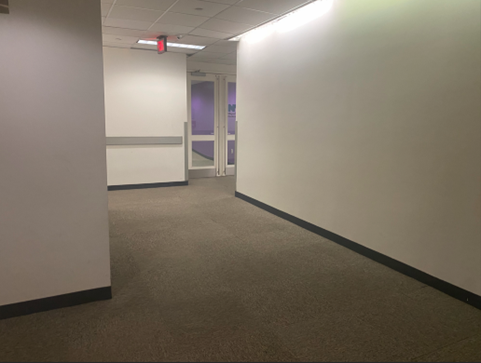
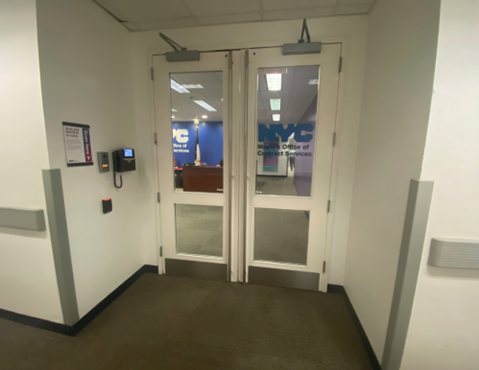
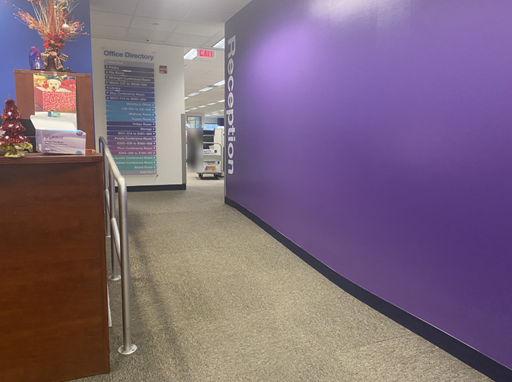
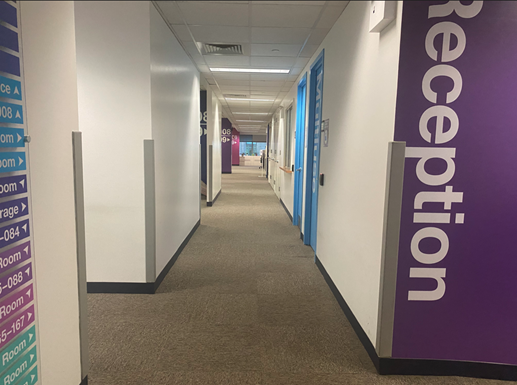
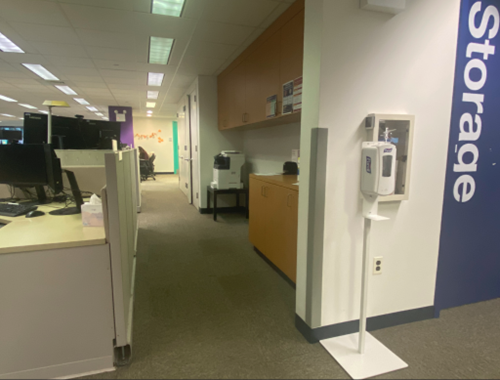
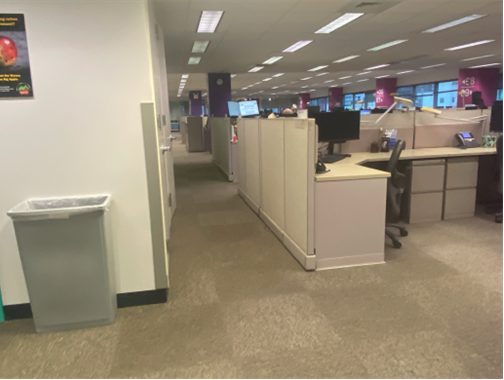
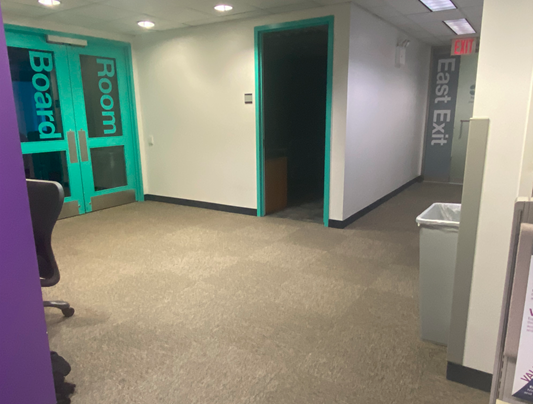
Appendix C
Employee Resource Groups at a Glance
Overview
An Employee Resource Group (ERG) is a voluntary, self-coordinating, employee-driven group formed by employees based on shared characteristics or common interests. ERGs foster a sense of community, engagement, and an inclusive work environment.
ERGs allow employees to connect with colleagues who share common personal or professional interests, share ideas, provide a forum to impact agency culture, and promote professional development and inclusivity. Example ERG focuses include: LGBTQIA+, Multi-faith, Environmentalism, or Young Professionals.
General Guidelines and Prohibitions
- Members must be MOCS employees, and the ERG must be voluntary and open to all employees without discrimination.
- ERG meetings must occur during personal time, though they can be scheduled during lunch hours. All MOCS and NYC code of conduct and EEO policies must be followed when participating in ERG activities, whether onsite or offsite.
- Activities at MOCS or involving the use of MOCS or City resources, time, or name must be approved by the MOCS EEO team and should be aligned with the broader objectives of MOCS in the workforce, office, and community.
- ERGs may not engage in any political activity.
- ERGs may not solicit money from their members for dues or fees or attempt to pressure any other employee into participating in an ERG or ERG associated activity.
- ERGs may not attempt to negotiate salaries, benefits, or other employment on behalf of other City employees.
Creation Process and Sponsorship
Creating an ERG requires the following:
- A completed ERG proposal form, which can be found on the MOCS Intranet.
- A meeting with the MOCS EEO team to discuss the proposal.
- An Executive Sponsor. If one was not identified initially by the prospective ERG, the EEO team can assist in finding one.
- An initial meeting for interested MOCS employees to attend and potentially join the ERG.
- Creation of a final Charter document outlining the ERG leadership structure, name, mission, and vision within the first three meetings.
Further Resources
Further resources can be found on the MOCS Intranet's Diversity and Inclusion page, including a complete ERG guide document here and a copy of the ERG proposal form to be submitted in DocuSign.
If you have any questions about ERGs, please contact the MOCS EEO team at EEO@mocs.nyc.gov.




